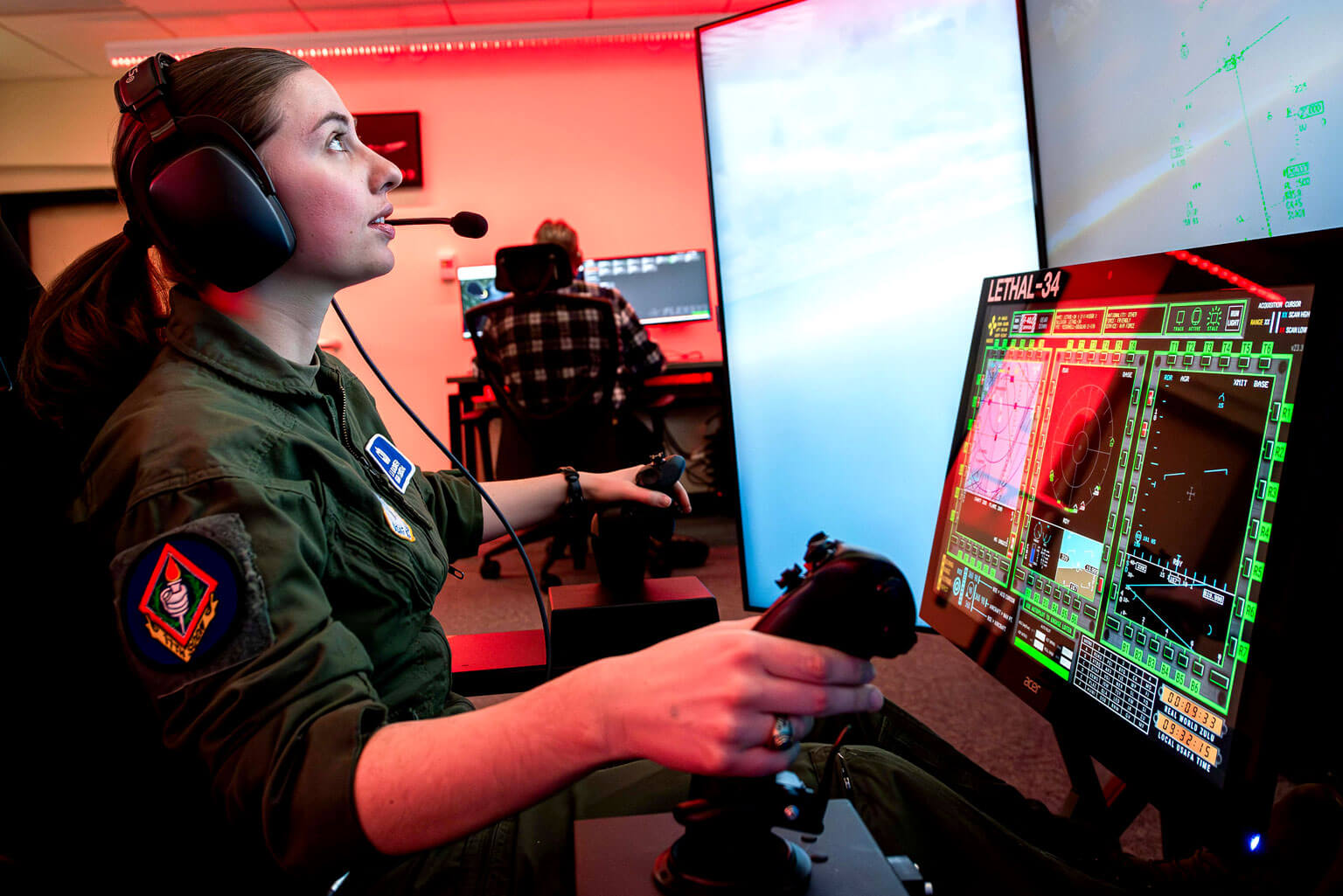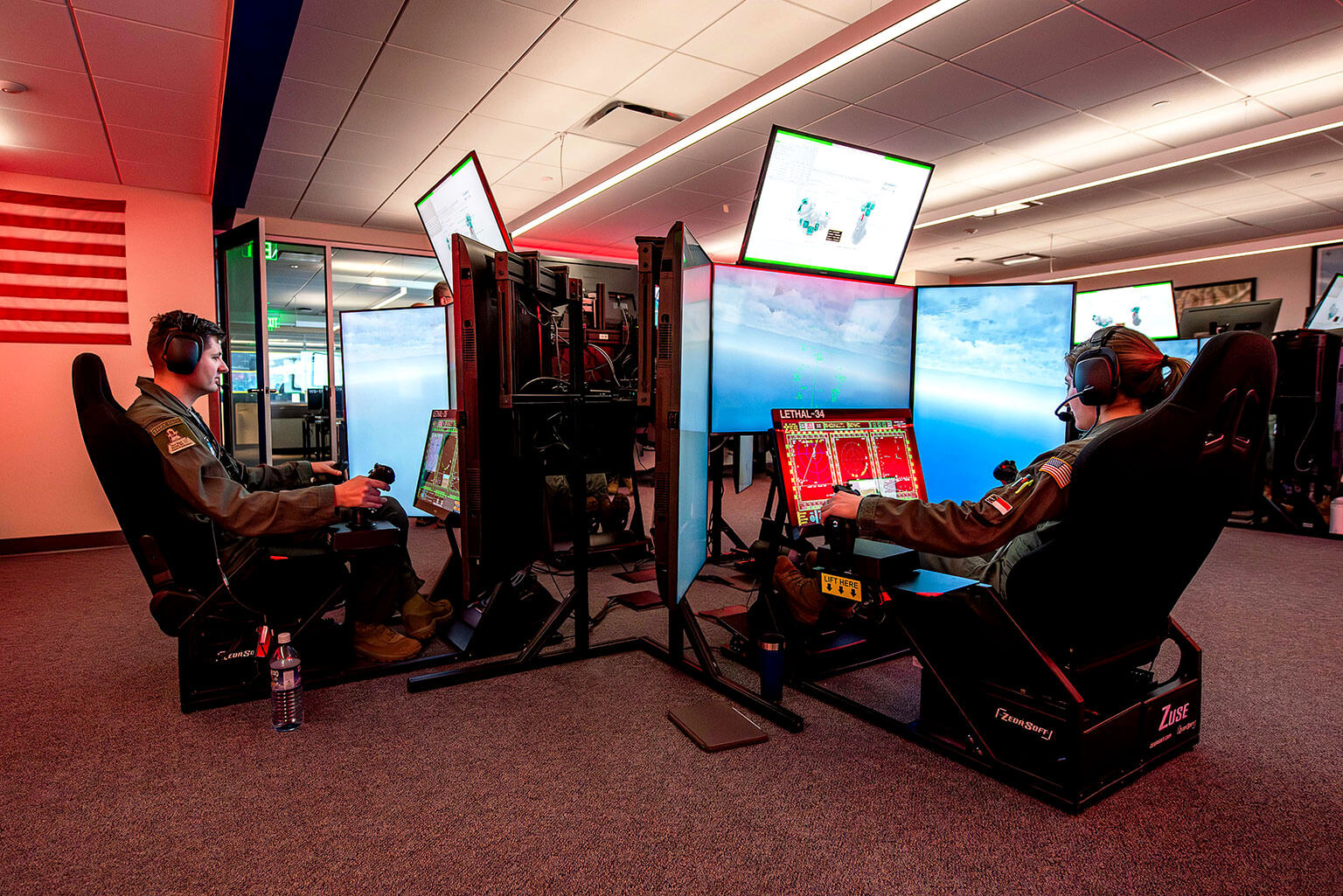Experts help cadets understand the future of war-fighting
 U.S. Air Force Academy Cadet 1st Class Lauren Blackwelder flies a simulator in the Multi-Domain Laboratory during the Firstie Flag exercise Feb. 10, 2024. The Institute for Future Conflict places cadets in the lab to provide a glimpse into missions in a potential conflict with a great-power adversary. (U.S. Air Force photo by Travis Cokley)
U.S. Air Force Academy Cadet 1st Class Lauren Blackwelder flies a simulator in the Multi-Domain Laboratory during the Firstie Flag exercise Feb. 10, 2024. The Institute for Future Conflict places cadets in the lab to provide a glimpse into missions in a potential conflict with a great-power adversary. (U.S. Air Force photo by Travis Cokley)
By Randy Roughton
U.S. Air Force Academy Strategic Communications
U.S. AIR FORCE ACADEMY, Colo. – First-class cadets eyeing the roles they will play in competition with other world powers will face different adversaries and threats than previous generations of officers.
The Institute for Future Conflict focuses on research and education that help create and cultivate flexible warfighters prepared to prevail in conflict regardless of what form it may take in the future.
Cadet 1st Class Garrett Bowers, a Biology major, will attend Nuclear and Missile Operations School at Vandenberg Space Force Base, California, after he graduates from the U.S. Air Force Academy. He feels prepared to face future challenges in the great-power environment, Bowers said.
“The staff told me things that I needed to know for my role as a missileer and in the Air Force,” Bowers said. “The other world powers have the same capabilities we do, so we must foster different interactions compared to what we had to do in the Middle East. It will be a tougher situation when it comes down to it but with the preparation coming from the Institute for Future Conflict, I feel prepared for the fight.”
Institute faculty work across mission elements and departments to provide timely education throughout a cadet’s educational career. Cadets can complete capstone programs, war-fighting minors and participate in the Martinson Honors Program. They receive classified briefings, instruction on artificial intelligence, access to senior military leaders and contested logistics instruction.
A shift to the future fight
“Across the Department of Defense, we have been fighting ISIS and al-Qaida in the Global War on Terrorism for the past 20-30 years,” retired Lt. Gen. B. T. Shwedo, the institute’s director, said. “We were narrowly focused on a lower end of conflict and those tactics, techniques, procedures and weapons. We’re shifting our focus toward a strategic competition or a larger-scale fight. We highlight that with our cadets and active-duty personnel.”
The creation of a new institute
The drive to create the Institute for Future Conflict began with a white paper by Dr. Paul Kaminski, a 1964 Academy graduate. Kaminski’s “Big Idea” asked Academy leadership how they could prepare cadets for future warfare more effectively. The Academy’s senior leadership partnered with the Air Force Academy Foundation to establish the institute in 2019. Two years later, Superintendent Lt. Gen. Richard Clark hired Shwedo, Class of 1987, as its first director. Schwedo oversaw all U.S. Air Force intelligence operations as the 25th Air Force commander. He retired as the Joint Staff director for command, control, communications and computer/cyber as chief information officer.
Instead of offering great-power conflict training to cadets in certain academic disciplines, Shwedo wants it available for all. Uniformed personnel represent the institute in various departments for two-year rotations. Those currently include a special operations pilot and former U.S. Northern Command speech writer, an F-22 Raptor and F-35 Lightning II test pilot, a computer space cyber specialist, and intelligence and space warfare officers. Moving forward, he is hiring a staff member to work in the Department of Athletics.
‘Raise all the boats’
“We put these people in their respective departments to raise all of the boats at the same time,” Shwedo said. “If you ask how many cadets interact with us, the answer is all of them. They may just not all realize it. We are raising all the boats to make our cadets better prepared than we ever were.”
One crucial lesson is to encourage cadets to think beyond air and space. Shwedo wants them to consider all domains attacking simultaneously. He uses a martial arts movie analogy to make the point. Do not just show up with a kung fu expert; bring in other attackers with their weapons as well, Shwedo said.
“We are telling cadets to change the math and use all the tools in their toolbox to learn lessons about our adversaries,” Shwedo said.
Aiming to be the best
However, institute staff also make it clear that they do not want a great-power war to ever happen. The goal is for competition and to “prepare for the Super Bowl but never want to go,” Shwedo said. The goal is to be the best at everything, he said. That benchmark includes recruiting.
“If we’re in a battle with the [Massachusetts Institute of Technology], Harvard or Stanford, I can take them to the Multi-Domain Laboratory,” Shwedo said. “You can go to one of those schools and work on a project that your professor thinks is cool. Or you can come here and work at [Defense Advanced Research Projects Agency] on a top-secret project that everybody thinks is cool. I think I win that game.”
Cadets also feel prepared as they leave their academic career and become military leaders. The stakes will be high, but Bowers said he feels empowered.
“I feel much more knowledgeable now,” he said.” Something I learned that was surprising was that our military chain of command is much stronger than [rival great powers] in how commands are passed down. I have a lot of trust in our system. With the knowledge the Institute for Future Conflict provided us, I can make a difference as a leader or a missileer.”
 U.S. Air Force Academy first-class cadets fly simulators in the Multi-Domain Laboratory Feb. 10, 2024. The Institute for Future Conflict places cadets in the lab to provide a glimpse into missions in a potential conflict with a great-power adversary. (U.S. Air Force photo by Travis Cokley)
U.S. Air Force Academy first-class cadets fly simulators in the Multi-Domain Laboratory Feb. 10, 2024. The Institute for Future Conflict places cadets in the lab to provide a glimpse into missions in a potential conflict with a great-power adversary. (U.S. Air Force photo by Travis Cokley)